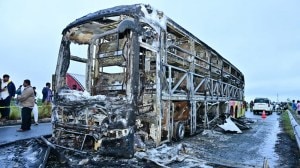Kinnaur still on high alert, Nathpa-Jhakri switches on
Power generation in four of six units of the Satluj Jal Vidyut Nigam (SJVN) project resumed today after a gap of one week even as the high a...

Power generation in four of six units of the Satluj Jal Vidyut Nigam (SJVN) project resumed today after a gap of one week even as the high alert along the banks of Spiti and Sutlej rivers from Sumdoh in Kinnaur to Kol dam in Bilaspur district of Himachal continued for the 10th day today.
The power generation resumed in two units of 250 MW each around 6.15 am after the Union Power ministry granted permission to project authorities on the condition that a system would be in place at Sumdoh to gauge the discharge of water of Spiti and Sutlej at Khaab monitoring station.
Meanwhile, the latest satellite imageries of the artificial lake at Pareechu in Tibet indicated that there was no increase in the size of the lake, and water was gradually overflowing, reducing the probability of bursting of the lake. SJVN Director (Civil) H. K. Sharma. said the water level in Satluj and Pareechu rivers was normal today.
The inflow of water into the lake, which was reported to be 30 cumecs, did not appear to be authentic as the outflow of water at Sumdoh was between 30 and 35 cumecs and about a dozen streams merged into Pareechu between the lake site and Sumdoh.
Experts monitoring the situation were of the view that water outflow exceeded its inflow. Also, with temperature going down every day, the inflow would be reduced further and the flash-flood threat would diminish in due course.
The satellite pictures of November 2003 show that there was a depression at the site due to blockade over river Pareechu. Experts opined that if the lake burst, all the water — estimated to be 64 million cubic metres — would not flush out in one go. Further, the thrust of water in the lower layers would not be enough to cause a major upheaval.
People shifted from the banks of Sutlej had been staying in alternative accommodation for the past 16 days. Now, panic has subsided to a great extent.





- 01
- 02
- 03
- 04
- 05


























